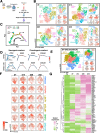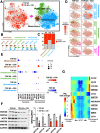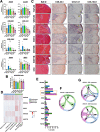Single cell transcriptomic analysis of human pluripotent stem cell chondrogenesis
- PMID: 33441552
- PMCID: PMC7806634
- DOI: 10.1038/s41467-020-20598-y
Single cell transcriptomic analysis of human pluripotent stem cell chondrogenesis
Abstract
The therapeutic application of human induced pluripotent stem cells (hiPSCs) for cartilage regeneration is largely hindered by the low yield of chondrocytes accompanied by unpredictable and heterogeneous off-target differentiation of cells during chondrogenesis. Here, we combine bulk RNA sequencing, single cell RNA sequencing, and bioinformatic analyses, including weighted gene co-expression analysis (WGCNA), to investigate the gene regulatory networks regulating hiPSC differentiation under chondrogenic conditions. We identify specific WNTs and MITF as hub genes governing the generation of off-target differentiation into neural cells and melanocytes during hiPSC chondrogenesis. With heterocellular signaling models, we further show that WNT signaling produced by off-target cells is responsible for inducing chondrocyte hypertrophy. By targeting WNTs and MITF, we eliminate these cell lineages, significantly enhancing the yield and homogeneity of hiPSC-derived chondrocytes. Collectively, our findings identify the trajectories and molecular mechanisms governing cell fate decision in hiPSC chondrogenesis, as well as dynamic transcriptome profiles orchestrating chondrocyte proliferation and differentiation.
Conflict of interest statement
F.G. is an employee of Cytex Therapeutics, Inc. The remaining authors declare no competing interests.
Figures







Comment in
-
Streamlining cell fate decisions during chondrogenesis.Nat Rev Rheumatol. 2021 Jun;17(6):313-314. doi: 10.1038/s41584-021-00604-3. Nat Rev Rheumatol. 2021. PMID: 33753905 No abstract available.
References
Publication types
MeSH terms
Substances
Grants and funding
LinkOut - more resources
Full Text Sources
Other Literature Sources
Molecular Biology Databases

